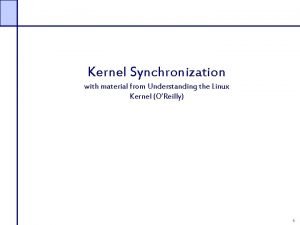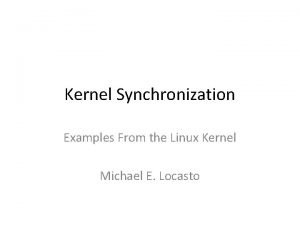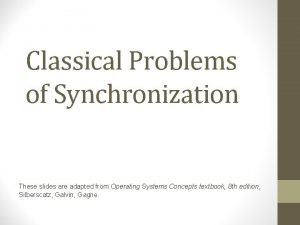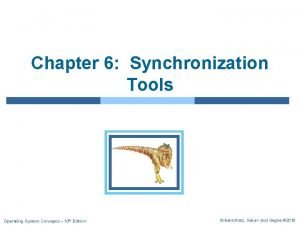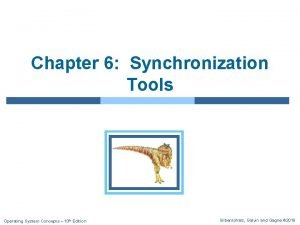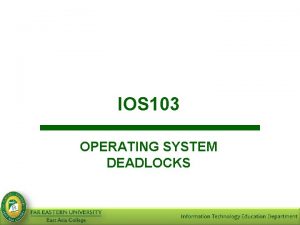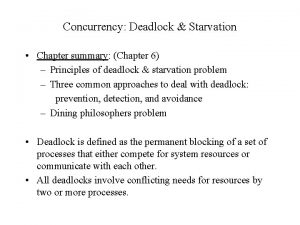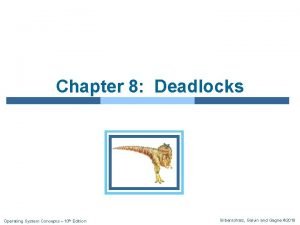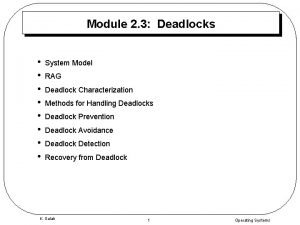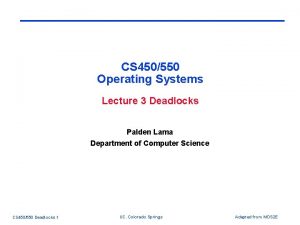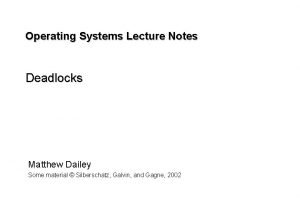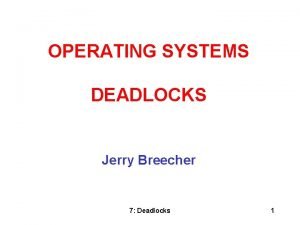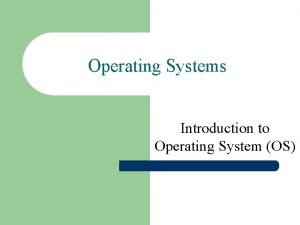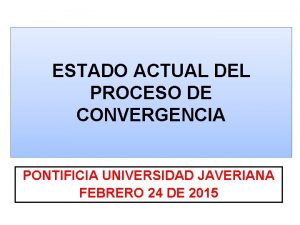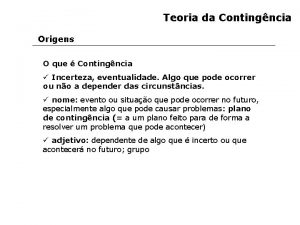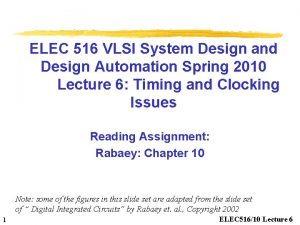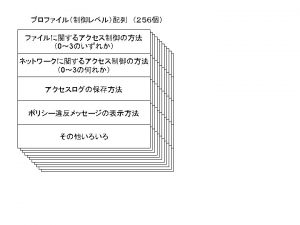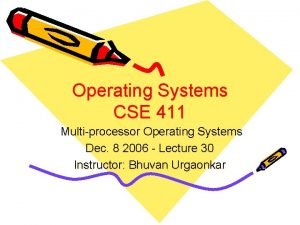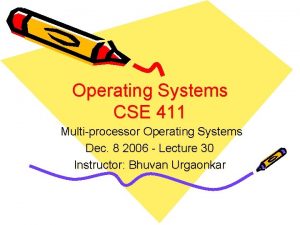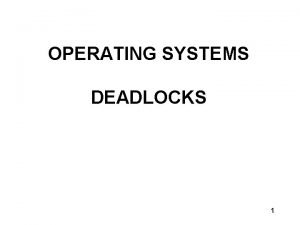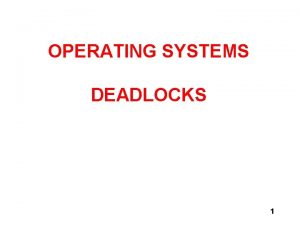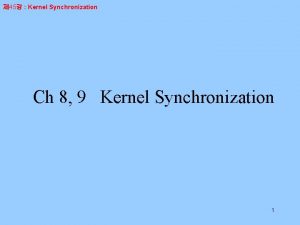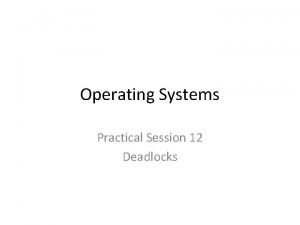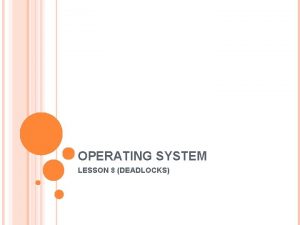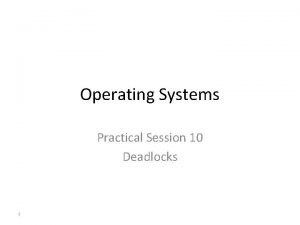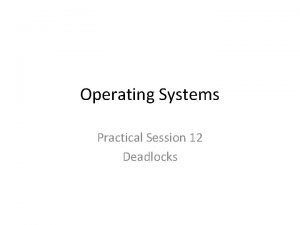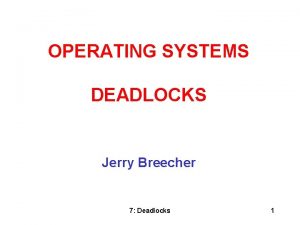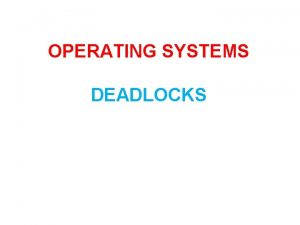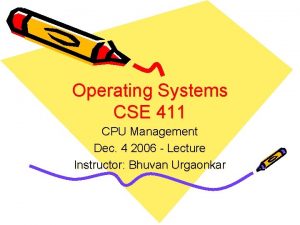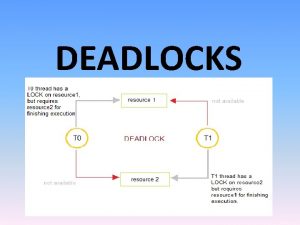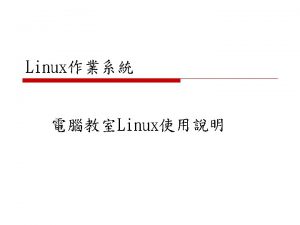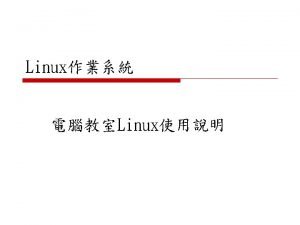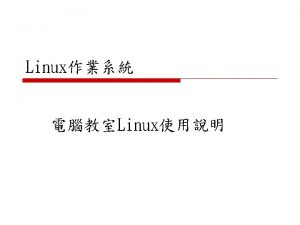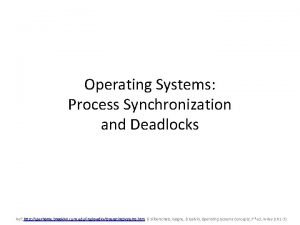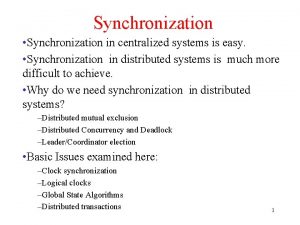Operating Systems CSE 411 Kernel synchronization deadlocks Dec






























- Slides: 30

Operating Systems CSE 411 Kernel synchronization, deadlocks Dec. 11 2006 - Lecture 31 Instructor: Bhuvan Urgaonkar

Symmetric Multi-threading • Idea: Create multiple virtual processors on a physical processor – – Illusion provided by hardware Called hyper-threading in Intel machines The OS sees the machine as an SMP Each virtual processor has its own set of registers and interrupt handling, cache is shared • Why: Possibility of better parallelism, better utilization • How does it concern the OS? – From a correctness point of view: it does not – From an efficiency point of view: the scheduler could exploit it to do better load balancing

Synchronization in SMPs & Kernel Synchronization

Synchronization building blocks: Atomic Instructions • An atomic instruction for a uni-processor would not be atomic on an SMP unless special care is taken – In particular, any atomic instruction needs to write to a memoy location – Recall Test. And. Set, Swap • Need special support from the hardware – Hardware needs to ensure that when a CPU writes to a memory location as part of an atomic instruction, another CPU can not write the same memory location till the first CPU is finished with its write • Given above hardware support, OS support for synchronization of user processes same as in uniprocessors – Semaphores, monitors • Kernel synchronization raises some special considerations – Both in uni- and multi-processors

Kernel Control Path • Recall: A kernel is a “server” that answers requests issued in two possible ways – A process causes an exception (E. g. , page fault, system call) – An external device sends an interrupt • Definition: Kernel Control Path – The set of instructions executed in the kernel mode to handle a kernel request – Similar to a process, except much more rudimentary • No descriptor of any kind – Most modern kernels are “re-entrant” => Multiple KCPs may be executing simultaneously • Synchronization problems can occur if two KCPs update the same data – How to synchronize KCP access to shared data/resources? �

Two mechanisms for easy to achieve kernel synchronization • Non-preemptible kernel design – A KCP can not be pre-empted by another one • Useful only for certain KCPs, such as those that have no synch. issues with interrupt handlers – Not enough for multi-processors since multiple CPUs can concurrently access the same data structure – Adopted by many OSes including versions of Linux upto 2. 4 – Linux 2. 6 is pre-emptible: faster dispatch times for user processes • Interrupt disabling – Disable all hardware interrupts before entering a critical section and reenable them right after leaving it – Works for uni-processor in certain situations • The critical section should not incur an exception whose handler has synchronization issues with it • The CS should not get blocked – What if the CS incurs a page fault? – Does not work for multi-processors

How to synchronize KCP access to shared data? • Can use semaphores or monitors • Not always the best solution in multi-processors • Consider two KCPs running on different CPUs – If the time to update a shared data structure is very short, then semaphores may be an overkill • Solution: Spin Locks – Do busy wait instead of getting blocked! – The kernel designers must decide when to use spin locks versus semaphores – Spin locks are useless in uni-processors: Why?

Deadlocks

The Deadlock Problem • A set of blocked processes each holding a resource and waiting to acquire a resource held by another process in the set. • Example – System has 2 disk drives. – P 1 and P 2 each hold one disk drive and each needs another one. • Example – semaphores A and B, initialized to 1 P 0 wait (A); wait (B); P 1 wait(B) wait(A)

Bridge Crossing Example • Traffic only in one direction. • Each section of a bridge can be viewed as a resource. • If a deadlock occurs, it can be resolved if one car backs up (preempt resources and rollback). • Several cars may have to be backed up if a deadlock occurs. • Starvation is possible.

Deadlock and starvation • Deadlock implies starvation but not the other way around • Recall Dining Philosophers

System Model • Resource types R 1, R 2, . . . , Rm CPU cycles, memory space, I/O devices • Each resource type Ri has Wi instances. • Each process utilizes a resource as follows: – request – use – release

Deadlock Characterization Deadlock can arise if four conditions hold simultaneously: Note: Necessary conditions but not sufficient • Mutual exclusion: only one process at a time can use a resource. • No preemption: a resource can be released only voluntarily by the process holding it, after that process has completed its task. • Circular wait: there exists a set {P 0, P 1, …, Pn} of waiting processes such that P 0 is waiting for a resource that is held by P 1, P 1 is waiting for a resource that is held by P 2, …, Pn– 1 is waiting for a resource that is held by Pn, and Pn is waiting for a resource that is held by P 0 => Hold and wait: a process holding at least one resources held by other is waiting to acquire additional processes.

Resource-Allocation Graph A set of vertices V and a set of edges E. • V is partitioned into two types: – P = {P 1, P 2, …, Pn}, the set consisting of all the processes in the system. – R = {R 1, R 2, …, Rm}, the set consisting of all resource types in the system. • request edge – directed edge P 1 �Rj • assignment edge – directed edge Rj �Pi

Resource-Allocation Graph (Cont. ) • Process • Resource Type with 4 instances Pi Rj • Pi requests instance of Rj • Pi is holding an instance of R Pi Rj

Example of a Resource Allocation Graph

Resource Allocation Graph With A Deadlock

Graph With A Cycle But No Deadlock

Basic Facts • If graph contains no cycles �no deadlock. • If graph contains a cycle � – if only one instance per resource type, then deadlock. – if several instances per resource type, possibility of deadlock.

Methods for Handling Deadlocks • Ensure that the system will never enter a deadlock state – Deadlock prevention and deadlock avoidance • Allow the system to enter a deadlock state and then recover – Deadlock detection and recovery • Ignore the problem and pretend that deadlocks never occur in the system; used by most operating systems, including UNIX – Some call it the “Ostrich” approach - why?

Plan for remaining classes • Penultimate class – A little history of operating systems • Significant events, important contributions, standards – What is happening now and what is likely to happen in the future • What is hot and what is not – Where could you (as a student) go from here? • Related fields • Last class – Revision of entire course – Tips for final • Both classes – Questions about the course – Feedback!

Deadlock Prevention Restrain the ways request can be made. • Mutual Exclusion – not required for sharable resources; must hold for nonsharable resources. • Hold and Wait – must guarantee that whenever a process requests a resource, it does not hold any other resources. – Require process to request and be allocated all its resources before it begins execution, or allow process to request resources only when the process has none. – Low resource utilization; starvation possible.

Deadlock Prevention (Cont. ) • No Preemption – – If a process that is holding some resources requests another resource that cannot be immediately allocated to it, then all resources currently being held are released. – Preempted resources are added to the list of resources for which the process is waiting. – Process will be restarted only when it can regain its old resources, as well as the new ones that it is requesting. • Circular Wait – impose a total ordering of all resource types, and require that each process requests resources in an increasing order of enumeration.

Deadlock Avoidance Requires that the system has some additional a priori information available. • Simplest and most useful model requires that each process declare the maximum number of resources of each type that it may need. • The deadlock-avoidance algorithm dynamically examines the resource-allocation state to ensure that there can never be a circular-wait condition. • Resource-allocation state is defined by the number of available and allocated resources, and the maximum demands of the processes.

Avoidance algorithms • Single instance of a resource type. Use a resource-allocation graph • Multiple instances of a resource type. Use the banker’s algorithm

Resource-Allocation Graph Scheme • Claim edge Pi �Rj indicates that process Pi may request resource Rj; represented by a dashed line. • Claim edge converts to request edge when a process requests a resource. • Request edge converted to an assignment edge when the resource is allocated to the process. • When a resource is released by a process, assignment edge reconverts to a claim edge. • Resources must be claimed a priori in the system.

Resource-Allocation Graph

Unsafe State In Resource. Allocation Graph

Resource-Allocation Graph Algorithm • Suppose that process Pi requests a resource Rj • The request can be granted only if converting the request edge to an assignment edge does not result in the formation of a cycle in the resource allocation graph

Deadlock Detection • Allow system to enter deadlock state • Detection algorithm • Recovery scheme – Terminate (deadlocked) process(es) – Preempt resources
 Linux kernel synchronization
Linux kernel synchronization Linux synchronization primitives
Linux synchronization primitives Classical problems of synchronization
Classical problems of synchronization Synchronization tools in operating system
Synchronization tools in operating system Synchronization tools in operating system
Synchronization tools in operating system Deadlocks can be described more precisely
Deadlocks can be described more precisely Deadlock summary by chapters
Deadlock summary by chapters Deadlocks can be described more precisely
Deadlocks can be described more precisely Deadlocks
Deadlocks Coffman deadlock
Coffman deadlock No preemption
No preemption Deadlocks
Deadlocks Resource allocation graph
Resource allocation graph Hierarchical structure of operating system
Hierarchical structure of operating system Clock synchronization in distributed system
Clock synchronization in distributed system Bi decagon
Bi decagon Dec usinage
Dec usinage Dec. 3022/13
Dec. 3022/13 Système impérial
Système impérial Nys dec decals
Nys dec decals 8th dec 2014
8th dec 2014 Ra dec
Ra dec Méth eth prop but
Méth eth prop but Dec 17
Dec 17 Tos dec.lawler
Tos dec.lawler Elec
Elec Propiedades químicas del carbono
Propiedades químicas del carbono Organic chemistry crash course
Organic chemistry crash course Organic and biochemistry
Organic and biochemistry 3 declinazione latina
3 declinazione latina Pref dec
Pref dec
